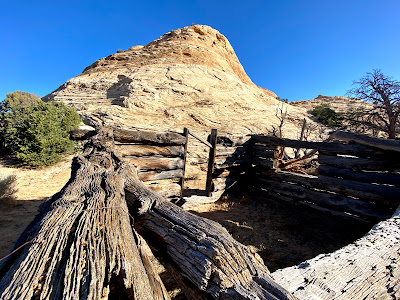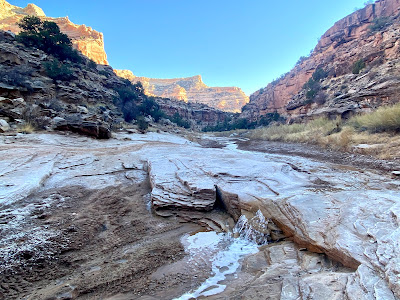Once again I found myself executing a bonehead adventure with my bud Nick.
This time we decided to head down to the northern San Rafael Swell for a full value day of linking several wonderful sections of wilderness in the Sid's Mountain area. We were both somewhat familiar with the terrain, as I had spent some time earlier this year exploring the first section of the run, while Nick had some experience in what would be the latter portion of the run.
The first weeks of November had me frothing to go splitboarding, but the snow situation deteriorated rapidly. As the week rolled on, it was apparent that Utah and most of the Intermountain West would remain high and dry after an otherwise promising start to winter, so splitboarding would have to wait. Thus, heading down south seemed like a reasonable thing to do.
Nick and I shot several plans back and forth, pored over some maps, and agreed on a relatively casual but long-ish 20-25 mile run. I am woefully out of running shape and anticipated a limping finish, but nevertheless was stoked to get down into the desert and further explore an area that continues to capture my interest.
On the drive in, we passed by the newly minted BLM Sid's Mountain Wilderness signs. Last time I was here, it was still a wilderness study area. Nice.
 |
Crisp, cloudless. Perfect late autumn desert running weather.
|
We left the truck around 8 AM and made quick time descending into the bottom of North Salt Wash. I was pleasantly warm as we jogged at a comfortable pace, hopping back and forth across the wash and passing several small beaver dams.
We followed cairns up to Sid's Mesa, climbing the slickrock terraces at a steady pace. Soon after topping out on the nondescript mesa (which lacks any real trail save for a pack trails), we gained our bearings and headed southeast to Sid's proper. Running through cedars on the mesa was probably the most type-1 part of the day. Just classic high desert cruising on open mesa.
 |
| Somewhere on the mesa, with Navajo sandstone domes in the back |
We made it to Sid's Cabin in great time, having taken no real breaks until then, and felt fit, energized, and stoked overall. I'd like to think that ol' Sid spent a lot of time up here on the mesa with nothing but his cows and thoughts. It's people like him that make me want to keep the headphones in the car on long outings like these. I wonder what he'd say about this whole wilderness area concept.
After poking around the old homestead and having a quick snack, we headed straight east toward the head of Virgin Spring Canyon. It was tempting to drop in here, but we stuck to the original plan and continued further along the rim to seek an entrance into Cane Wash.
The southern rim of the "Little Grand Canyon" afforded expansive views across the flats and buttes below: Oil Well Flat, Limestone Bench, Window Blind Peak, all dusty and useless. I love every bit of it.
We crossed an improbable section of canyon rim that pinches together between Virgin Springs Canyon and No Man's Mountain, and ambled our way along the rim searching for an entrance into Cane Wash. It turns out there's no obvious points of descent, but we found a saddle between Virgin Springs Canyon and Cane Wash that would lead to a somewhat convoluted descent. After a ~900ft descent into Cane Wash, we were off the mesa and in the cool, shady reaches of the canyon bottom.
Unfortunately, the aches, pains, and chafes came way earlier than scheduled. While I knew my body would break down at some point during this run (I had averaged only 7 mile weeks over the past few months), I was hoping to last a bit longer.
After an extended break, some stretches, and a few Ibuprofens, I tried to jog along the sandy bottom of Cane Wash, but my IT bands were not having it. I felt great mentally and physically, but my knees were screaming. I was frustrated to say the least. Power hiking still felt fine, and we continued along the Wash Bottom at a fast hiking clip.
 |
| A little bit of jogging, a little bit of walking. OHV tracks through most of the wash. Blechkkk. |
We found a clear flowing stream midway through the wash. At this point, I was nearly out of water and decided to refill my bladder. The day before, I de-bunged my filter with some vinegar, but forgot to thoroughly rinse the vinegar out before packing it in my runner vest. In turn, the creek water tasted like old vinegar and was more or less undrinkable. The weather was cool enough to prevent any noticeable sweating, so I felt comfortable moving on without refilling the bladder.
 |
| Cane Wash inspires |
Right before exiting Cane Wash and heading into the San Rafael River proper, we ascended through a notch that split the sheer sandstone walls, saving ourselves some travel time. Daylight was still on our side, but we realized that we didn't have much of it left, and we probably would be finishing in the dark. Here's to hoping that the San Rafael River Stretch would go by quick!
 |
| This notch seemed like a very obvious spot for early inhabitants/canyon travelers to convene |
The San Rafael River Stretch did not go by quick, and is the obvious contender for most type-2.5 fun of the day. At first it wasn't so bad, as we ambled through cattle pastures and along sandbars with empty dreams of getting to the mouth of North Salt Wash by dark. Soon, the pastures and sandbars became choked with brush and my legs started to get thrashed, so I switched back to spandex. A nice relief, and my IT band felt a bit better, so we managed some more jogging. After a while, though, the terrain became even more brushy, winding, and unfavorable to running, so we switched back to hiking. At current, we were at 20-25 miles, and realized that we would be covering much more ground than we had initially hoped.
 |
| Still type-1-ish, though with dwindling daylight |
 |
| Less type-1 |
We did as much canyon wall and riverbank skirting as we could, but we accepted the inevitable: we'd have to cross the San Rafael River. We were running out of daylight, and it didn't make sense to spend our time searching for improbable sneaks to avoid river crossings.
We moved as quickly as I felt we could. We knew that moving along the San Rafael River in the dark would be bad, since it was probably more than hip deep in parts. After a handful of icy river crossings, I started to become numb to the process (*ba-doom-ch*), and we pushed along, accepting nightfall and getting cold.
After the 6th crossing, we were very, very close to the mouth of North Salt Wash and dreaded the idea of crossing the river two more times. With the freezing cold creeping in and our fatigue levels rising, it seemed quite dangerous. After some canyon wall skirting, we reached a pinch point that edged off into what looked like a deep river pool, but we couldn't really tell by headlamp. Frustrated, we backtracked and searched for a means to get up onto the shelf above us. We found a climbable pourover and were soon sidehilling our way toward North Salt Wash.
We came across the first people we saw all day at the confluence of North Salt Wash and the San Rafael River. They had a camp set up and a small fire going. I was somewhat relieved to see them, but their words were anything but a relief: "North Salt Wash is a bit complicated and actually winds back and forth across the wash." Nick and I were hoping that North Salt Wash would be a breeze, so this was discouraging to say the least.
I didn't even want to look at my map, knowing that it would do little to raise my spirits. Nick and I had a joke going, where Nick would occasionally look at the map and say, "We're making progress." Indeed.
North Salt Wash was snowy overall, and we leapt across the narrow creek numerous times. We got turned around occasionally, but knew that staying more or less along the creek would bring us back to where we started our day.
Cold, tired, sore as boils, we reached the North Salt Wash exit and started our climb up the slickrock and back to the unmarked TH I hadn't noticed how fatigued I was until this last climb. The final bit of walking felt dreamlike, and we were back at the truck in a little over 12 hours, cold and ready to eat.
The entire route was entirely off trail (unless you count faint and inconsistent pack trails), and was the longest distance I've covered on foot in a single push to date. I am looking forward to more long distance desert efforts like this, but will do a bit more conditioning before the next one.
The northern San Rafael Swell deserves all of the adoration, protection, etc.
Total mi: 33
Total elev.: 3,366 ft.
Elapsed time: 12:18
Food: banana, gu, 3 chews, pro bar, 2 clif bars, 8 macaroons
Water: 1.5L
River Crossings: 6
Times Nick and I agreed that this was a "big ol' day": 50
Total amount of nut butter applied to the nether regions: 10 tbsps
Strava: https://www.strava.com/activities/4376552092


































